9TH Grade Science [Earth Science] |
|
|--The Study of Earth Science
|--The Scientific Method
|--Science and Mathematics
|--Maps and topography
|--Models of the Earth
|--The atmosphere
|--Weather and climate
|--Climate and the Water Cicle
|--Plate Tectonics
|--Earthquakes
|--Volcanoes
|--Studying the Past
|--Views of the Earth's Past
Required Textbook: A Beka, Physical Creation, Work-Text, Pensacola, Florida, current edition.
[a] Key ideas about the solid Earth.
[i] Energy resources are derived from the upper layers of the lithosphere (crust) by drilling and mining; they include fossil fuels (coal, oil, natural gas), nuclear fuels and geothermal sites.
[ii] Materials of the lithosphere are the source for all soils.
[iii] The Earth's dimensions may be determined by direct or indirect measurements.
[iv] The Earth's composition and structure are known from detailed studies of surface materials, volcanoes, drill hole samples, and inferences made from geophysical data.
[v] Physical and chemical laws control the formation and characteristics of minerals and rocks.
[vi] All rocks may undergo changes by long-term exposure to different environments. The rock cycle represents these changes.
[vi] The relative ages of rocks and events in Earth's history can be determined by applying the laws of uniformitarianism, original horizontally, superposition, cross-cutting relationships, and inclusions.
[vii] The age of the Earth and individual events in history can be determined by various radiometric dating techniques.
[viii] Earth's lithosphere is composed of large pieces called plates, which can be oceanic, continental, or both. The plates move in response to seafloor spreading, to give the appearance of what Alfred Wegener called continental drift.
[ix] Evidence of plate movement includes continental fit, age of the sea floor, studies of Earthquake foci, paleomagnetism and magnetic reversals, and direct measurement using satellites. The rate of plate movements is measured in centimeters per year.
[x] Earth's continental and oceanic features are mostly the result of movements of lithospheric plates.
[b] Key ideas about water.
[i] In the water cycle, water undergoes constant changes in location, phase [state], and energy level.
[ii] New water is introduced into the atmosphere and hydrosphere by volcanic activity and [predominantly small] comet impacts.
[iii] Many mineral, petroleum, and gas resources were formed in ancient oceans.
[iv] Both renewable and non-renewable resources come from present-day oceans. These resources include minerals, energy, food, and drinking water.
[v] Huge amounts of water are stored underground in the openings between mineral and rock fragments.
[vi] The abundance of underground water is directly related to climatic factors; its quality and availability are dependent upon the Earth materials through which it moves and the possible influence of surface activities.
[vii] All bodies of surface water undergo change within a comparatively short span of geologic time. Streams change in position, gradient, and discharge. Lakes fill with sediment and may become eutrophic.
[viii] The kinetic energy of flowing surface water causes the water to erode the landscape over which it flows. When the level of kinetic energy of a stream diminishes, the stream may deposit sediment on the landscape.
[c] Key ideas about the air.
[i] The atmosphere is a mixture of gases that absorbs, transmits, reflects, and radiates solar energy. The composition of the atmosphere has changed through geologic history.
[ii] The atmosphere is relatively thin compared to the Earth's dimensions and provides life on Earth with a protective shell against harmful solar radiation.
[iii] The atmosphere interacts with the Earth's crust, water, and life: The chemical interaction between these spheres includes the rock cycle, water cycle, oxygen cycle, carbon cycle, nitrogen cycle, and sulfur cycle.
[iv] The physical properties of water and its abundance have significant effects on weather. Water can absorb and transfer tremendous amounts of heat energy, particularly during changes in phase during evaporation and condensation.
[v] Low and High pressure areas have a significant effect on weather. The rotation and transverse motion depend on their latitude and prevailing wind belts.
[vi] Wind blows as a result of differential heating, which results in differences in atmospheric pressure.
[vii] Weather fronts are borders between air masses of different temperature and moisture. Changes in weather and possible precipitation are associated with weather fronts.
[viii] The observation, measurement, and analysis of the atmosphere are the basis for preparing weather forecasts.
[d] Key ideas about ice.
[i] Thick masses of ice (glaciers) accumulate on land, they will move either downslope or outwardly by plastic-like flow of the ice and slippage due to water in the ice.
[ii] Movement of glaciers over land surfaces results in the formation of characteristic erosional and depositional features.
[iii] Long-term changes in solar radiation reaching the earth's surface (insolation) would alter the volume of year-round ice. Changes in the volume of glacial ice would result in global changes of sea level, weather patterns, and climate.
[iv] The cryosphere provides potential hazards on the land and in the oceans. Widespread melting of the Earth's glaciers and snow fields would cause worldwide rise of sea level. Widespread accumulation of ice would cause glaciers to spread over land now occupied by humans.
[e] Key ideas about life
[i] During the first two billion years on earth, only single-cell microorganisms existed. Once cells with nuclei appeared about a billion years ago, increasingly complex multicellular organisms have flourished.
[ii] Fossils reveal information such as how (meat eaters or plant-eaters) and where (marine or terrestrial) the organisms lived, their physical structures (vertebrate or invertebrate); anatomical features (e.g., teeth),; and chemical composition (e.g., shells).
[iii] The study of fossils and their distribution provides information on water temperatures, depths, and composition (fresh or marine), and contributes to our understanding of paleogeography and the changes that have taken place during Earth's history.
[iv] The succession of fossil assemblages in the stratigraphic column provides insight into the changes in life forms through exceedingly long intervals of time.
[f] Key ideas about Earth in space.
[i] Historical events displaced the idea that the earth was the center of the universe.
[ii] The universe is estimated to be over ten billion years old, and that its entire contents expanded explosively from a hot, dense, chaotic, massive body.
[iii] The Solar System includes the Sun, planets with their moons and planetary rings, comets, asteroids, and meteors.
[iv] As a planet in the Solar System, the Earth has some unique features that include liquid water, plant and animal life, large Moon, and atmosphere with mostly nitrogen and oxygen.
[vi] The nebular theory states that the Solar System began as a large cloud of gas and dust called a nebula about five billion years ago.
[vii] The distances between objects in the Solar System and galaxy are so great that they have to be measured through indirect techniques [in astronomical units, light years, and parsecs.]
[viii] The Solar System is part of a large system of stars called the Milky Way galaxy. The Solar System revolves around the center of the galaxy.
[ix] Because of the vast distances in the Universe, the light reaching our eyes and instruments from distant objects is millions of years old. Thus, our present view is actually a view of history.
[x] Gravity is a force that exists between any two masses. The magnitude of the force is proportional to the masses and weakens rapidly with increasing distance between them.
[g] Key ideas about the nature of science and scientific inquiry.
[i] How to formulate a testable hypothesis.
[ii] Scientists view the universe as a vast single system and the rules that govern it are the same everywhere. The rules may be simple or complex, but scientists believe they can be understood through careful, systematic study.
[iii] The usefulness of a model can be tested by comparing its predictions to actual observations.
[iv] Most changes that take place in the scientific view are small modifications of prior knowledge. Occasionally major shifts occur in the scientific view of how the world or the universe work, but these are rare.
[v] Testing, revising, and occasional discarding of theories, new and old, never ends. This process leads to an increasingly better understanding of how things work in the world but not to absolute truth.
[vi] Progress in all fields of science depends on intelligence, hard work, imagination, and even chance.
[vii] Tables, graphs, and symbols are alternative ways of representing data and relationships that can be translated from one to another.
[viii] Extremely large and small numbers can be represented in many different ways that make them easier to work with and compare to one another.
|
1.1 - The Study of Earth Science
Earth Sciences, the science of the Earth, is concerned with understanding:
Earth Science can be divided into four main fields or subject areas:
Geology: The study of the Earth, and in particular the history, the structure, the evolution of life, and the processes that have molded the Earth and its inhabitants. The coming of the space age has also extended the field to include the solid planets of the solar system.
Although often attracted to the study of geology by an aesthetic appreciation and enjoyment of the earth, geologists commonly approach their studies from an interest either in the academic or the applied aspects of the science.
Oceanography: A relatively young discipline, shaped by a continual flow of exciting discoveries. Although the oceans represent more than 70 percent of Earth's surface, as few as fifty years ago 98 percent of the floor remained unexplored.
In the last four decades, oceanographers gave us our first glimpse of the Earth's deepest ocean trenches as well as breathtaking views of our water planet from outer space. They confirmed the theory of plate tectonics and continental drift. They discovered exotic life forms around hydrothermal vents—creatures that depend on the special water chemistry surrounding the vents instead of light, to survive. And today, oceanographers continue to help us understand the precarious balance of the oceans, atmosphere, ice, solid earth, and living organisms—the Earth system that affects our everyday lives and the future of our planet.
Meteorology: The science of the atmosphere. It takes its name from the Greek word meteoron-something that happens high in the sky. The ancient Greeks observed clouds, winds, and rain and tried to understand how they are connected to one another. The weather was important in their relatively simple society because it affected the farmers who raised their food and their seamen who sailed the oceans. Today, our complex society and our environment are affected even more seriously by events and changes in the atmosphere. We must address many complicated issues and answer many difficult questions about the behavior of the atmosphere and its effects on the people of our planet.
Astronomy: Divided into two main branches, distinguished as astrometry and astrophysics; the former concerned with determining the places of the investigation of the heavenly bodies, the latter, with the investigation of their chemical and physical nature.
Earth Sciences puts the human race in planetary perspective within space and time. As our awareness of human interactions with the environment increases, our need for better understanding of the way the earth works becomes more urgent.
A grounding in Earth Sciences is seen as essential for those concerned with care of the environment and assessment of natural hazards, as well as for those involved with utilising Earth's resources. Solutions to problems of pollution and waste disposal, to major civil engineering problems such as those encountered at dam sites, and to the effects of global change arising from human impact on the environment, must all be sought in the framework of Earth Sciences.
1.2 - The Scientific Method
Scientific inquiry into the physical world is mostly gained by observations made by our senses. Science assumes a rational universe, and laws of nature which are the same everywhere, and laws which are applicable both in the microscopic and macroscopic worlds.
Frequently science is faced with describing extremely complex events; such as weather patterns, where the number of variables is very great and the system changes rapidly in time. Fortunately modern high speed computers have helped immensely with data processing.
Today's scientific discoveries rest on the foundations of previous generations. Just like the scientists before us, our ability to do science then depends on a set of presuppositions and assumptions and on an underlying philosophy. There are rules to be follow and a protocol to be observed, this set of rules and protocol is called the scientific method.
In the scientific method, an experiment is used to search for cause and effect relationships in nature. In other words, an experiment is designed so that changes to one item cause something else to vary in a predictable way. These changing quantities are called variables,

So what does a scientist do when he or she uses the scientific method in the exploration of the unknown? First of all, the scientist tries to learn as much about a subject as possible. This requires a thorough study of the available literature, gathering information and data from a variety of sources, discussions with colleagues, and a lot of thinking. After the data has been collected and analyzed, the scientist formulates a hypothesis. The researcher then designs experiments to provide evidence in support of the hypothesis. The experiment may involve creating a theoretical model, which may be tested on a computer. Whatever form the experiment takes, the scientist must gather substantial amounts of data. Analysis of the data will either suggest the validity of the hypothesis or encourage revision. Once revised and retested, the hypothesis must withstand the scrutiny of other scientists as well. They may repeat the experiment to retest the validity of the hypothesis, along with the validity of the methods used to test the hypothesis. An idea, model, or explanation that has been rigorously tested, analyzed, and accepted by the scientific community is referred to as a theory. This term is used, because most scientists believe nothing can ever be proved absolutely true. At best, they will say a theory hasn't been proved false. The theory will continue to be an accepted explanation unless new information is uncovered; information that the scientific community agrees disproves the previous explanation. This continuous scrutiny is essential to the credibility and progress of scientific research.
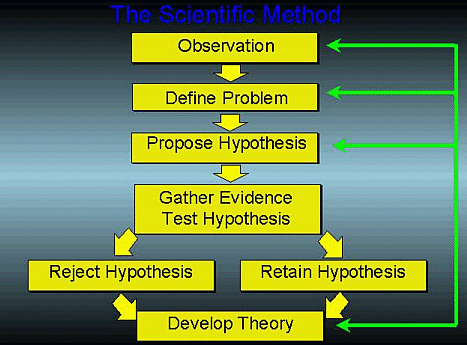
Accuracy and Precision
The foundations of scientific inquiry in the physical sciences rest on developing the skills to pose a scientific question, to develop, to test and to apply a scientific model that adequately accounts for the observed phenomena. One of the fundamental prerequisites of a healthy scientific method is the quality of experimentation that is designed to test a hypothesis.
When we discuss measurements or the results of measuring instruments there are several distinct concepts involved which are often confused with one another. The first distinction you have to make as a scientist is between accuracy and precision. The term accuracy refers to how close a result or measurement is to the actual value. The term precision refers to the reproducibility of a result or measurement.
A common analogy is an archer shooting arrows at a target.
If the archer shoots three arrows, misses the bull's-eye, and the three attempts are not near each other, then the archer is inaccurate and imprecise,

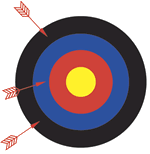
If the archer shoots three arrows in a tight group, his shooting would be considered precise. The accuracy of the archer would be determined by the location of the group of arrows. If the group were outside the bull's-eye area, the archer would be precise but not accurate,


If the arrows found their way to the bull's-eye area, the archer would be both accurate and precise,


The goal of any scientist is to achieve both accuracy and precision in their experimental results and measurements.
Units: The International System
The International System of Units (abbreviated SI from the French language name Système international d'unités) is the modern form of the metric system. It is the world's most widely used system of units in science. At the heart of the SI is a short list of base units defined in an absolute way without referring to any other units. The base units are consistent with the part of the metric system called the MKS system. In all there are seven SI base units:
- the meter for distance,
- the kilogram for mass,
- the second for time,
- the ampere for electric current,
- the kelvin for temperature,
- the mole for amount of substance, and
- the candela for intensity of light.
| Prefix | Abbreviation | Meaning | Example |
|---|---|---|---|
| mega- | M | 106 | 1 megameter (Mm) = 1 x 106 m |
| kilo- | k | 103 | 1 kilogram (kg) = 1 x 103 g |
| centi- | c | 10-2 | 1 centimeter (cm) = 1 x 10-2 m |
| milli- | m | 10-3 | 1 milligram (mg) = 1 x 10-3 g |
| micro- | μ | 10-6 | 1 micrometer (μg) = 1 x 10-6 μg |
| nano- | n | 10-9 | 1 nanogram (ng) = 1 x 10-9 g |
Each SI unit is represented by a symbol, not an abbreviation. The use of unit symbols is regulated by precise rules. These symbols are the same in every language of the world. However, the names of the units themselves vary in spelling according to national conventions. Therefore, it is correct for Americans to write meter and Germans to write Meter, and it is also correct for the British to write metre, Italians to write metro, and Poles to write metr.
Units: The fps System
The absolute fps system of units is based on the foot, pound, and second as units of length, mass, and time, respectively. The fps system has two variants, known as the American version and the Imperial version. Neither scheme is often used by scientists nowadays; the International System of Units (SI) is preferred. However, fps units are used to some extent by the general public, especially in the United States.
One foot (1 ft) represents a length of 12 inches. The inch was originally defined as the length of three typical barleycorns laid end-to-end. A foot was also approximately equal to three hand widths or 2/3 of a cubit (the distance from an average person's elbow to the tips of the fingers). Nowadays, a foot is considered to be 0.3048 meter.
One pound (1 lb) is the force that produces an acceleration of 32.1740 feet per second squared (32.1740 ft/sec2) when applied against a known standard mass. The acceleration of 32.1740 ft/sec2 is approximately the value of the earth's gravitational acceleration at 45 degrees north latitude.
One second (1 s or 1 sec) is the time that elapses during 9.192631770 x 109 cycles of the radiation produced by the transition between two levels of Cesium 133. It is also 1/86,400 of a mean solar day. (There are 60 seconds in a minute, 60 minutes in an hour, and 24 hours in a day; 60 x 60 x 24 = 86,400.)
Mass and Weight
Mass and weight are not the same thing. True, these terms are used interchangeably in ordinary conversation, but scientists converse somewhat differently. Mass is a fixed property of an object and does not depend on anything outside the object. It defines how much there is of the object and is related to its inertia. Weight, on the other hand, is the force required to support an object against the pull of gravity. A common illustration of this is when the same physics teacher who weighs 160 pounds on Earth weighs less on the Moon (same mass with less gravity equals less weight).
1.3 - Science and Mathematics
When doing science problems, you'll often be required to determine the numerical value and the units of a variable in an equation. The numerical value usually isn't too difficult to get, but for a novice, the same can't be said for the units.
Dimensional analysis, is a useful method for determining the units of a variable in an equation. Another use of dimensional analysis is in checking the correctness of an equation which you have derived after some algebraic manipulation. Even a minor error in algebra can be detected because it will often result in an equation which is dimensionally incorrect.
| Example 1 | Example 2 | |
| With this method, you can easily and automatically convert very complex units if you have the conversion formulas. The method involves the following steps | Convert 6.0 cm to km | Convert 4.17 kg/m2 to g/cm2 |
| 1. Write the term to be converted, (both number and unit) | 6.0 cm | 4.17 kg m2 |
| 2. Write the conversion formula(s) | 100 cm = .00100 km | 1.00 m = 100 cm 1.00 kg = 1000 g |
| 3. Make a fraction of the
conversion formula, such that a) if the unit in step 1 is in the numerator, that same unit in step 3 must be in the denominator. b) if the unit in step 1 is in the denominator, that same unit in step 3 must be in the numerator. Since the numerator and denominator are equal, the fraction must equal 1. |
.00100 km 100 cm |
1000 g 1.00 m 1.00 m 1.00 kg 100 cm 100 cm |
| 4. Multiply the term in step 1 by the fraction in step 3. Since the fraction equals 1, you can multiply by it without changing the size of the term. | 6.0 cm .00100 km 100 cm |
4.17 kg
1000
g 1.00 m 1.00 m m2 1.00 kg 100 cm 100 cm |
| 5. Cancel units | 6.0 100 |
4.17 |
| 6. Perform the indicated calculation rounding the answer to the correct number of significant figures. | .000060 km or 6.0 E -5 km | .417 g cm2 |
Unit factors may be made from any two terms that describe the same or equivalent amounts of what we are interested in. For example, we know that
So to convert 20 centimeters to its inches equivalent,
1.0 in
20 cm --------- = 7.87 in
2.54 cm
1.4 - Maps and topography
In the 2003 film The Lord of the Rings: The Return of the King, Sauron's dark forces mount an unprecedented attack, culminating in the massive Battle of the Pelennor Fields on the outskirts of Minas Tirith. Gondor calls for military aid from Rohan. The message is carried by lighting fires across a mountain range. Use the map of Middle Earth to estimate the distance and direction the message had to travel.
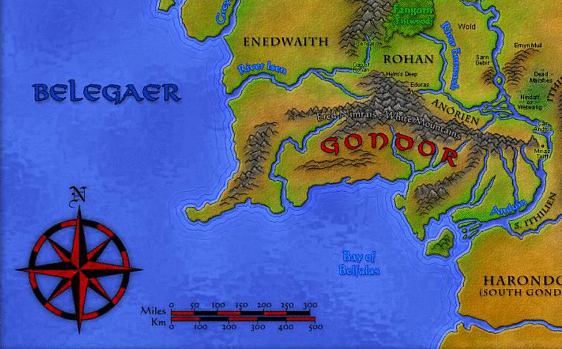
A map is a picture or representation of the Earth's surface, showing how things are related to each other by distance, direction, and size. Maps are a way of showing many things about a portion of the earth's surface on a flat piece of paper that can be carried and transported easily. A map is not a photograph of the Earth's surface. It can show many things that a picture cannot show, and as a result, a map looks different in many ways from a photograph of the Earth's surface. Maps have been used for centuries. A person who creates map as a profession is called a cartographer.
Maps are useful only if you know how to read it. The first thing to know is the map's compass direction. This is often shown by using a compass rose like the one in the lower left corner of the map of Middle Earth. This particular compass rose shows which way is NORTH. From that information, you can tell where south, east, and west are located. Thus we can say that the message from Gondor to Rohan traveled in between the north and the east, which we call northeast.
Another important part of the map is the scale. The map scale is the relationship between a unit of length on a map and the corresponding length over the ground. The map of Middle Earth carries a graphic bar scale. Graphic scales provide a direct measure of the distance over the ground represented by the corresponding distance on the map. Graphic scales are simple to use and can make estimating distances a very straightforward task. Graphic scales also have a unique benefit they remain accurate even if the map image is enlarged or reduced. A good estimate of the distance that the message from Gondor to Rohan traveled is about 150 miles or three bar segments in the upper graphic scale.
Topography deals with the graphic representation of the surface features of a place or region on a map, indicating their relative positions and elevations. Topographic data are among the most important data sets for many scientific, technical, and other applications. Even when not used directly in a study, topographic data are often used in preparing visualization tools. If you want to explore the earth's surface, one of the most helpful tools is a topographic map.
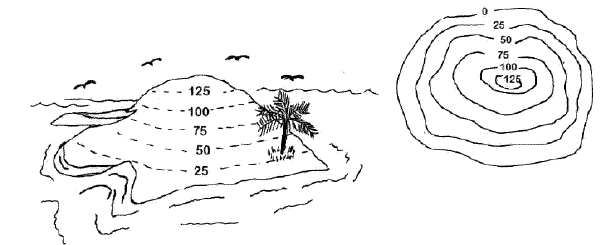
Topographic maps show a 3 dimensional world in 2 dimensions by using contour lines. Contour lines are curves that connect contiguous points of the same altitude. Many people have trouble reading these maps, because they have mountains and valleys are represented with concentric circles and lines. Many hikers use topographic maps, especially in areas where there are no roads with signs. Geologists depend on topographic maps to record the types of rocks. Engineers use topographic maps when they are planning roads, buildings, or other human–made structures.
1.5 - Models of the Earth
Some people still believe that the earth is flat. And a few believe that the earth is hollow. There is all sorts of evidence that the earth is round, but not hollow, including common sense. Columbus obviously knew that the world was round. Later, Magellan's ships sailed all the way around the earth. That proved that the world was round. But that had already been proved, back in Greek times. Most educated people knew that the world was round. The most convincing proof was that you could see the earth's shadow on the moon, during a lunar eclipse. During partial eclipses (and at the beginning and end of a total eclipse) the edge of the earth's shadow is always round, a portion of a circle. For this to happen every time, from all angles, the earth would have to be a sphere.
The only reason that people might doubt that the earth is round is that it is huge, and it looks flat locally. A person's first impression is that it is flat. Consider an ant, on a fully inflated basketball, who thinks that the basketball is flat.
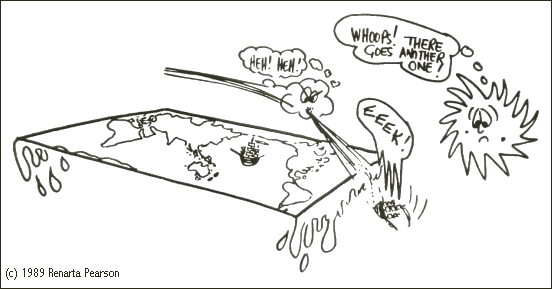
The Earth is round like a ball, we are all standing at odd angles around the Earth. It just doesn't feel like it because of the force of gravity. You are pulling on the Earth just as hard as it is pulling on you. However, since you weigh so much less than the Earth, you do not affect its motion at all. However, the earth has a big pull on you. This pull is what keeps us all from flying off into space.
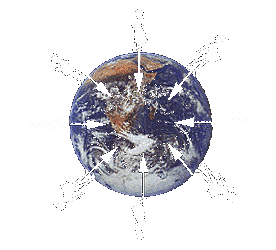
Every object pulls towards its center. If you look at the arrows on above the picture, you will see that they all point to the center of the Earth. This is the direction of gravity.
|
2.1 - The Atmosphere
...
The Greenhouse effect
The greenhouse effect is a naturally occurring process that aids in heating the Earth's surface and atmosphere. It results from the fact that certain atmospheric gases, such as carbon dioxide, water vapor, and methane, are able to change the energy balance of the planet by absorbing longwave radiation emitted from the Earth's surface. Without the greenhouse effect life on this planet would probably not exist as the average temperature of the Earth would be a chilly -180 Celsius, rather than the present 150 Celsius.
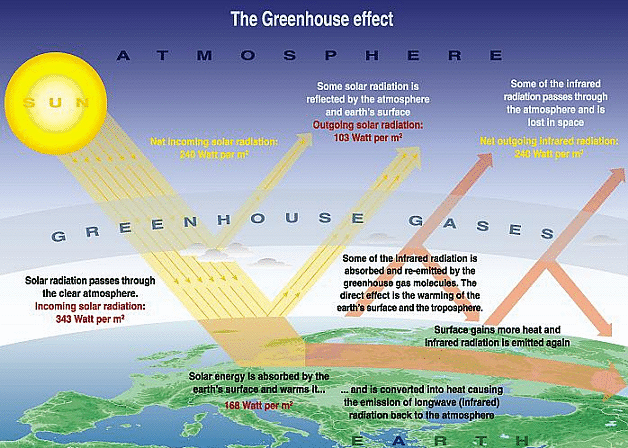
How does the greenhouse effect work?
- Sunlight reaches earth. It has an intensity of 1360 W/m2, and the average over all the earth is 343 W/m2. Remember, the average includes day and night, from the equator to the poles. Most solar energy has a wavelength close to 0.5 µm.
- 49% of the incoming sunlight goes straight through the atmosphere and it is absorbed by earth's surface, mostly in the tropical ocean.
- 31% of the incoming sunlight is reflected back to space, 22% by clouds, and 9% by the surface.
- The remaining 20% is absorbed in the atmosphere.
- Sunlight that is absorbed by earth's surface warms the surface.
- The surface cools primarily in two ways:
- All surfaces radiate heat, mostly at wavelengths close
to 10 µm wavelength. On average, they radiate 390 W/m2.
This is more than the incoming solar heat, and earth would rapidly
cool if there were no greenhouse gases.
- 90% of the infrared radiation emitted by the surface is absorbed by greenhouse gases in the atmosphere.
- 10% of the infrared radiation emitted by the surface goes directly to space, mostly in polar regions.
- The ocean evaporates, losing latent heat. On average, two meters of water is evaporated from the tropical ocean each year. In addition, small amounts of water evaporate from land and plants on land. On average 78 W/m2 is lost by evaportion. All latent heat is released in the atmosphere when the evaporated water condenses as water in clouds and rain. This warms the atmosphere.
- All surfaces radiate heat, mostly at wavelengths close
to 10 µm wavelength. On average, they radiate 390 W/m2.
This is more than the incoming solar heat, and earth would rapidly
cool if there were no greenhouse gases.
- 7% of the infrared radiation absorbed by the atmosphere is radiated to space by clouds.
- 93% of the infrared radiation absorbed by the atmosphere is quickly re-radiated radiated back to the earth. This warms the earth.
Thus greenhouse gases absorb radiation from earth's surface, and reradiate
most of it back to the surface, keeping the surface warm. If there were
no greenhouse gases, the surface would rapidly radiate heat away to space.
2.2 - Weather and Climate
In simple terms, weather is what happens outside. The air, or atmosphere, around us behaves in different ways.
It changes when it's hot or cold, and when it's wet or dry. It acts differently when it's calm or stormy, and clear or cloudy.
The atmosphere reacts to everything from rain to sunshine. Sometimes the atmosphere behaves violently, and sometimes it's peaceful and quiet.
Climate is the average weather in a location over a long period of time. A place that doesn't get much rain over many years would have a dry climate.
A place where it stays cold for most of the year would have a cold climate. Climate helps determine when the best time would be for farmers to plant their crops.
Although an area's climate is always changing, the changes do not usually occur on a time scale that's immediately obvious to us.
While we know how the weather changes from day to day, subtle climate changes are not as readily detectable.
Weather patterns and climate types take similar elements into account,
The temperature of the air is directly related to the amount of energy which is derived from the sun's solar radiation.
The higher the temperature, the higher the amount of energy in the air. Temperature is measured using a thermometer with units in degrees Celsius or Fahrenheit.
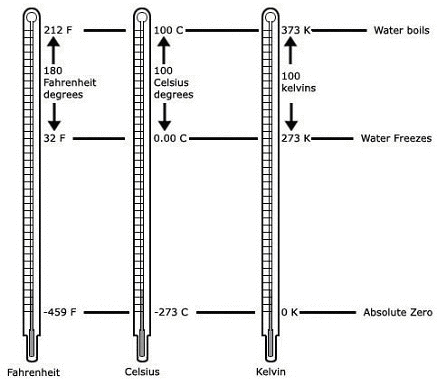
Commonly used temperature scales
Measurements of temperature of the air are taken away from direct sunlight or its reflected radiation. Meteorologists place thermometers in Stevenson's screens that consist of louvers allowing air but minimal sunlight to flow. In other words, air temperature is that measured in the shade.
The humidity of the air
The type and amount of precipitation

...
Air pressure
...
Wind speed and direction
...
...
|
3.1 - Plate Tectonics
...
|
4.1 - Studying the Past
...
[1] A Beka, Physical Creation, Work-Text, Pensacola, Florida.
[2] Steele, D., Parker, G., Science of the Physical Creation in Christian Perspective, A Beka Book, Pensacola, Florida, 2003.